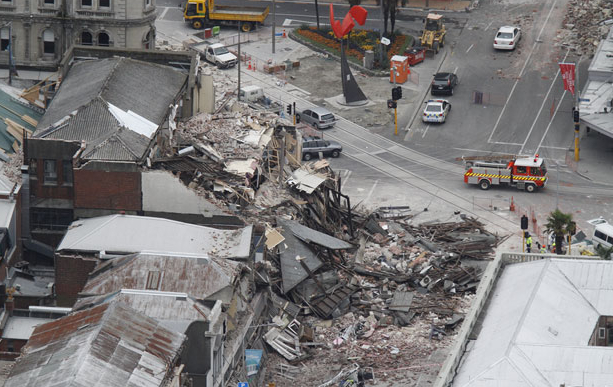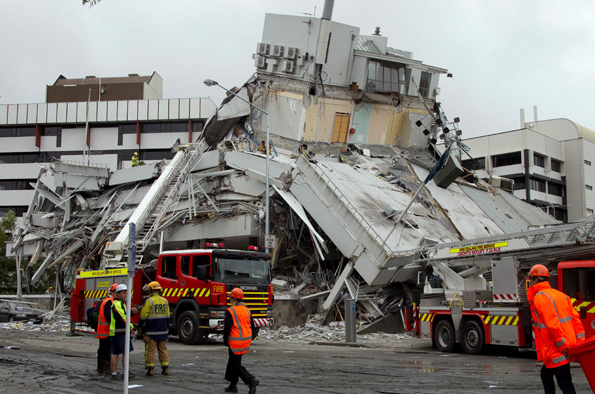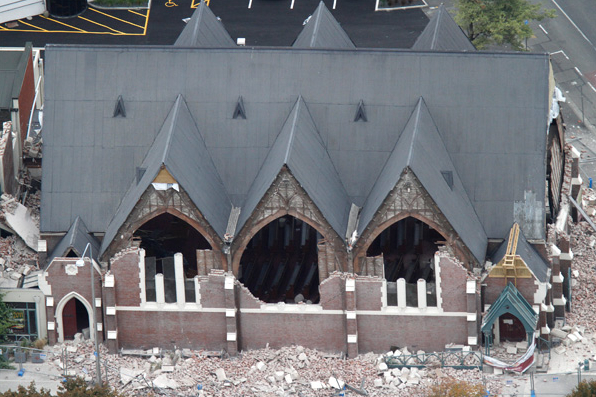As is most of the country, the Fish bloggers are stunned at the gravity of the situation down south – and we’re from the city that was expecting the next big one to happen to us. We noted back in September that we had escaped narrowly from death and disaster – not so lucky this time. Our wise, wizened and warily experienced commenter, the hard as concrete “60 MPa” wrote then about Wellington’s chances:
“In a decent (7+) shake here in the Well, Petone’s gone, Upper Cuba is shopfront collapse, Mirimar peninsula will need those boats, SH2 to Hutt is probably out and Ngauranga could be dicey. Ngaio Gorge should hold once the rockfalls are cleared. A decent 4WD and a good boat on the trailer launched on a calm day could be the best way out of town. Te Aro flat will be.
A spare stack of a dozen sheets of plywood in the garage is a good idea, if they were sized to your largest windows that’d just be fancy. Extra points will be awarded for a cubic metre of sand in the garden somewhere and a collection of flat empty synthetic sacks ready for filling. Generators are smelly but an inverter off the car battery will charge ya cell but after a few days that’ll be useless. Radio. Nothing wrong with canned food.”

So in the 6 months since then, and almost exactly 80 years after the Napier earthquake (still New Zealand’s most costly natural disaster in terms of human life), is New Zealand any better prepared? The Arch Centre website is noting that Wellington needs “to face the reality of an equally (or, far in excess of) grim destruction.” How is Wellington’s preparedness doing?
Has your organisation been having earthquake preparedness drills? Has your brick chimney been strengthened or removed? Does your apartment building have a steel frame, a concrete frame, or do you live in a building made of brick or stone? Because, when it comes down to it, that’s the simple answer: gravity sucks. Christchurch’s buildings are showing just that – in 2 or 3 seconds, if there is no reinforcement in the stones or bricks, then it has little chance of staying upright. But regardless of that, shouldn’t the more modern structures be staying upright? What happened here?

Post-script update 25/2/2011: One of our commenters has suggested that New Zealand should have just one earthquake zone, instead of the 3 we have at present. We include here the NZ Earthquake zone mapping.

It is certainly shocking to see how it carefully puts Christchurch into the Low / Medium Risk category, when that certainly doesn’t seem to equate with the recent spate of quakes in the South Island.






Daringly slender columns? I dunno – I’m no expert…
The question is, I guess, did the buildings fail to withstand the lateral acceleration that they had been designed for, or did the actual event exceed these design loads? If it is the former, there have to be big questions asked, and a whole lot more in-depth assessment of a greater range of structures previously considered to have been at less risk. If it is the latter, then we might expect to see a change to standards for both new buildings and eq strengthening across the country (which is, of course, bad for heritage).
See the image linked to for google streetview shots of both the PG and the CTV buildings in better days:
http://27.media.tumblr.com/tumblr_lh1bc6upPg1qz5gamo1_500.jpg
Nevertheless, this is stuff for afterwards, there are a whole lot more pressing issues happening on the ground right now…
I should add, wrt to the structural failing of the buildings, that I suspect any analysis is going to be made very difficult given the likely possibility of pre-existing damage from Canterbury EQ 1 last year…
[…] Maximus describes what would happen in Wellington […]
interesting commentary from LA Times
http://latimesblogs.latimes.com/lanow/2011/02/quake-experts-surprised-by-level-of-destruction-in-new-zealand-see-parallels-california-dangers.html
When the New Zealand earthquake struck Tuesday, Jason Ingham was preparing for a seminar on earthquake building standards in a Christchurch hotel, which began to shake.
He and his colleagues from the University of Auckland had studied damaged structures after the last Christchurch quake, which struck in September of last year. But he said they could feel immediately that Tuesday’s quake was more intense.
“Our instinct is that this exceeded the loads that even the modern buildings were designed for. We are almost certain,†said Ingham, who is an associate professor of civil engineering. “The assumption is that an earthquake of this size would have caused damage in any modern city anywhere.â€
I argued at the time, lack of real damage in Sept actually made for complacency. Why was any old brick non-earthquake strengthened building allowed to be occupied given the chance of a significant aftershock?
Given the potential for undiscovered fault lines anywhere in NZ, got to think sensible structural solution is one zone for whole of NZ instead of 3.
[…] Maximus describes what would happen in Wellington […]
http://i.imgur.com/0vZbD.jpg
Found this over on the PAS thread – taken immediately after the quake
I second the words of Jason Ingham – also it is time to look askance at 200 series block walls – I think that they may have been the walls on the Pyne Gould Blg?
Get down to Wigan St by 5pm for donating practical goods
The current request is for 20L water containers
http://eq.org.nz/reports/view/105
The Herald has an interesting article today on this front:
http://www.nzherald.co.nz/nz/news/article.cfm?c_id=1&objectid=10708327
The Grand Chancellor Hotel – never one of Christchurch’s most beautiful efforts, is now one of the real problem areas that Christchurch faces. Whole city blocks are cordoned off, while we wait for it to decide to fall. And if it doesn’t?
You may remember, after the Sept 11 twin trade tower destruction, that another building fell down in the vicinity. Just last year, nutters from the US toured NZ claiming that this multi-storey building had been secretly, purposefully, skillfully destroyed in the heat of the moment, by invisible secret CIA backed demolition experts, who somehow crept into the building with several tonnes of explosives and fuses, and climbed the damaged building, attaching explosives to the frame so that the whole building imploded in on itself. And no one saw them arrive or leave….
Yes, that is what we need now. The Grand Chancellor has done its job in getting people out safely – now it needs to be brought down quickly. I do not want to make light of the situation in Christchurch. But I think we can all see now that demolition of multi-storey buildings is not such an easy job after all.
i would also question if these buildings had actually suffered some damage in the previous quake that when coupled with the new one caused the building structures to fail? Had the reinforcing within the columns and beams been weakened enough. They did there job on Sept 4th and let everyone get out, but should they then have been condemned?, and in the case of the hotel it did it again the other day, but the other buildings did not. Do we know enough about what re-curring major events do?. Should everthing pre-70’s codes now be forensically examined structurally before deciding is they shoudl remain?
No – everything should now be forensically examined, not just pre-70s stuff. Accounts suggest that there isn’t going to be much left in the CBD once that processed is completed – But that said, that is how it should be – destruction by us, after the event, rather than during it…
And you are absolutely correct about not knowing enough – we will learn a great deal once we get past the rescue stage is over and safety is secured. Too late for many lives, but hopefully will place us in a better position for the inevitability of future events. I expect EQ building codes to be revisited as a consequence, and not in terms of relaxation as PC has the indecency to promote the very next day after the quake: http://www.blogger.com/comment.g?blogID=11906042&postID=7658663609025155146
Sad to hear of the passing of Christchurch architect Don Cowey who was killed by a falling rock in Redcliffs during the earthquake. RIP.
http://www.nzherald.co.nz/christchurch-earthquake-victims/news/article.cfm?c_id=1503038&objectid=10708605
Here is a link to some of his houses http://www.christchurchmodern.co.nz/tag/don-cowey/
Why do we need CBDs? I know in cities such as Auckland and Sydney that head offices are spread well and far. People move to be near their workplaces.
Why put all your eggs in the one basket?
If you move out of the central city then there is no need to have high rise buildings as space is not such an issue. (More than 3 stories is a risk apparently.)
Why not move some offices to places like Timaru and Oamaru? They could do with an economic boost. I’d move there in a flash if I had a decent paying job to go to..I’m sure others would too.. Instead I’m forced to remain here in earthquake prone Welly..
good question – Why DO we need CBDs? There is a serious issue, even before the earthquakes, with a dying central CBD. In Christchurch, in particular, the shopping habits have already spread to be focused on vast suburban malls, surrounded by carparks. Many of the upper floors of the old ChCh CBD buildings were empty, or under-utilised (not the big modern buildings, but the old brick buildings which have now largely been destroyed).
The NZIA apparently had an exhibition running called Before and After, where the question of what to do with the ChCh CBD was being addressed: http://www.beforeafter.co.nz/index.html
Just heard a slightly snippy exchange between Kim Hill and Celia Cyclist on National Radio – Celia was trying to make the point that buildings are earthquake resistant rather than eq-proof but she did say that as far as Welly is concerned she thought that the time given to owners to improve strength would be reduced. Unless owners are to accelerate plans to strengthen then I fear that that means more demolitions on the ground here in town.
If owners can’t afford renovation then the only short term option for some will be carparks